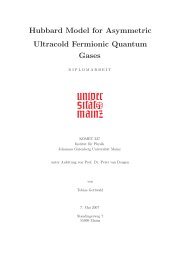5 Hirsch-Fye quantum Monte Carlo method for ... - komet 337
5 Hirsch-Fye quantum Monte Carlo method for ... - komet 337
5 Hirsch-Fye quantum Monte Carlo method for ... - komet 337
You also want an ePaper? Increase the reach of your titles
YUMPU automatically turns print PDFs into web optimized ePapers that Google loves.
5.2 Nils Blümer<br />
1 Introduction<br />
A conventional starting point <strong>for</strong> the study of strongly correlated electron systems is the Hubbard<br />
model, which in its single-band version reads<br />
ˆH = −t �<br />
〈ij〉,σ<br />
� ĉ †<br />
iσ ĉ jσ + h.c.� +U �<br />
i<br />
ˆni↑ˆni↓<br />
where ĉiσ is the fermion annihilation operator at site i with spin σ ∈ {↑,↓}, ˆniσ = ĉ †<br />
iσ ĉiσ is<br />
the density of fermions with spin σ, t parameterizes the hopping amplitude, and U is the onsite<br />
interaction. Un<strong>for</strong>tunately, numerical <strong>method</strong>s <strong>for</strong> its direct solution are either restricted to<br />
one-dimensional cases or suffer in general from severe finite-size errors and/or sign problems.<br />
Insight into the physics of higher-dimensional systems, thus, requires the use of additional<br />
approximations. The dynamical mean-field theory (DMFT) neglects inter-site correlations by<br />
assuming a momentum-independent self-energy; it becomes exact in the limit of infinite coordination<br />
number. The DMFT maps the lattice problem onto a single-impurity Anderson model<br />
(SIAM), supplemented by a self-consistency condition[1]. Its enormous success within the last<br />
20 years would not have been possible without the availability of controlled numerical solvers<br />
<strong>for</strong> (multi-orbital) SIAMs, in particular of the auxiliary-field <strong>Hirsch</strong>-<strong>Fye</strong> <strong>quantum</strong> <strong>Monte</strong> <strong>Carlo</strong><br />
(HF-QMC) algorithm[2].<br />
These lecture notes are aimed at a pedagogical introduction to the HF-QMC based <strong>method</strong> of<br />
solving the DMFT self-consistency problem, i.e, of computing electronic properties of Hubbardtype<br />
models (possibly derived ab initio <strong>for</strong> a specific material from density functional theory<br />
or using the GW <strong>method</strong>, see subsequent lecture by K. Held) at the DMFT level. As will become<br />
clear in the following, the usage of the HF-QMC impurity solver within the DMFT selfconsistency<br />
cycle has several important implications that would not arise in HF-QMC solutions<br />
of some fixed SIAM. For example, statistical <strong>Monte</strong> <strong>Carlo</strong> errors might prevent the detection of<br />
metastable DMFT fixed points and can, in general, lead to systematic biases in observables (in<br />
all stochastic <strong>method</strong>s including continuous-time QMC); the <strong>for</strong>mulation in imaginary time (in<br />
all QMC <strong>method</strong>s and some IPT variants) implies that (i) analytic continuation is necessary <strong>for</strong><br />
obtaining spectral in<strong>for</strong>mation and (ii) that Fourier trans<strong>for</strong>ms have to be used within the DMFT<br />
cycle which are especially problematic in the case of a uni<strong>for</strong>m time grid (as in HF-QMC); finally,<br />
the discretization error of estimated observables in (conventional) HF-QMC is impacted<br />
in a quite irregular way due to the self-consistency (cf. Fig. 17) and makes the location of phase<br />
boundaries difficult. Thus, a large part of these lectures will go beyond the HF-QMC algorithm<br />
itself; we will try to discuss all issues that a researcher should understand (or at least be aware<br />
of) when evaluating or producing DMFT data on the basis of HF-QMC. On the other hand, we<br />
wish to avoid unnecessary complexity in the presentation, in particular in the <strong>for</strong>malism. There<strong>for</strong>e,<br />
we will mainly restrict the treatment to the single-band case (1) which is representative<br />
also of multi-band models with (spin) density-density type interactions <strong>for</strong> which HF-QMC is<br />
most competitive and mainly used, but will also point out generalizations where appropriate.<br />
In the remainder of this introduction, we will briefly recapitulate the DMFT and establish the<br />
(1)













